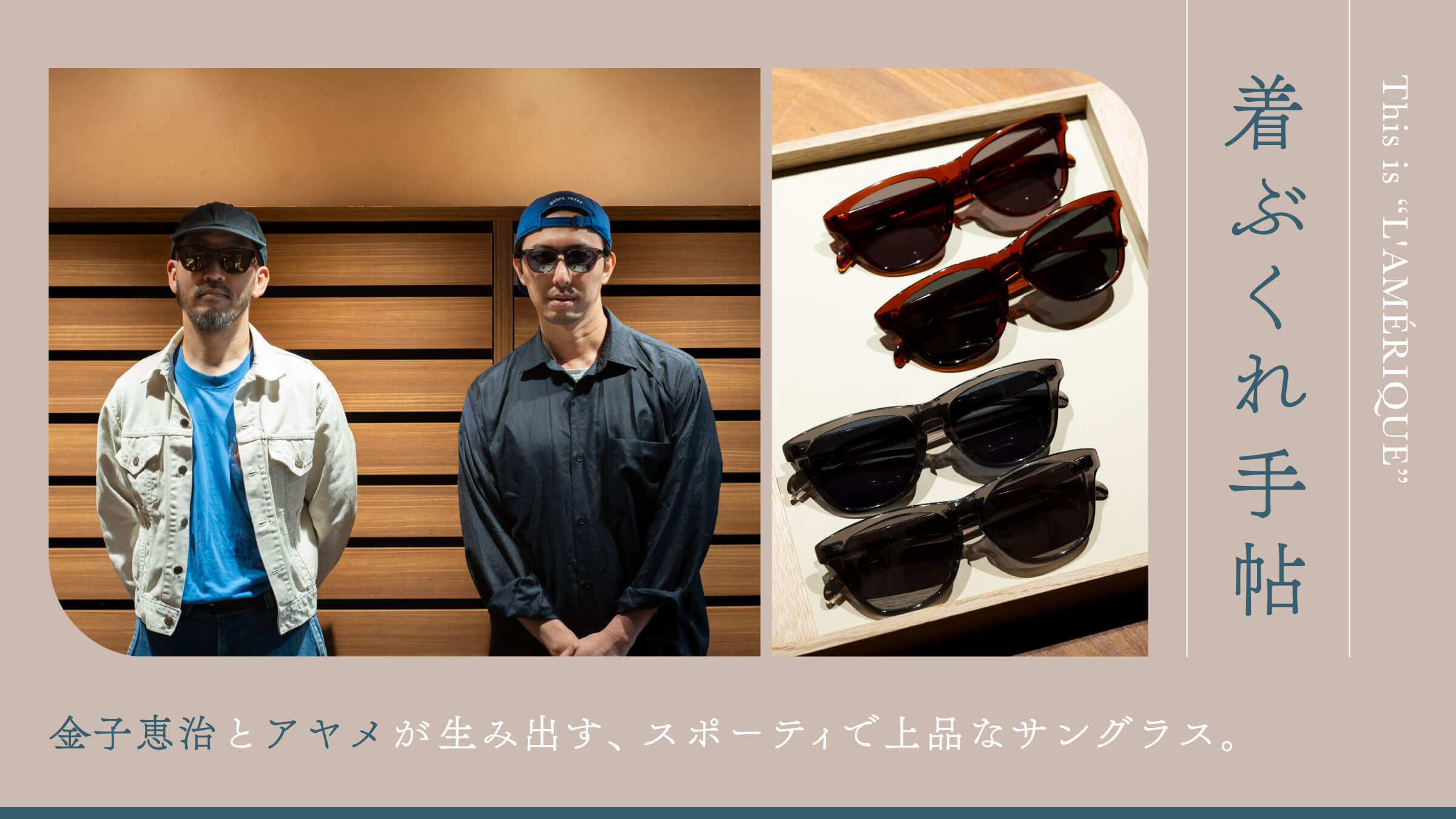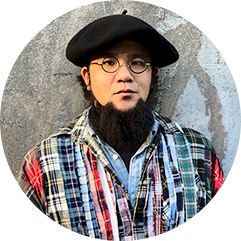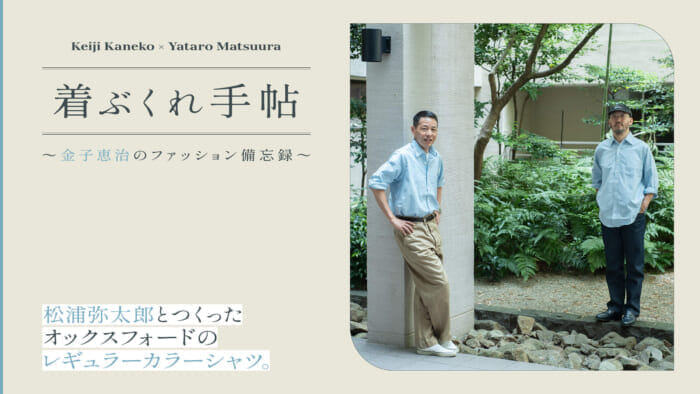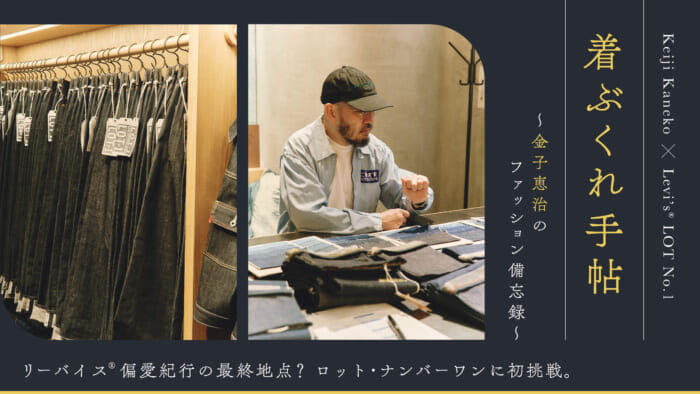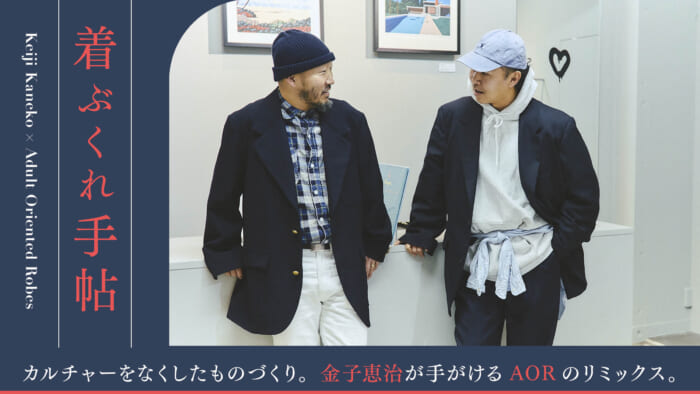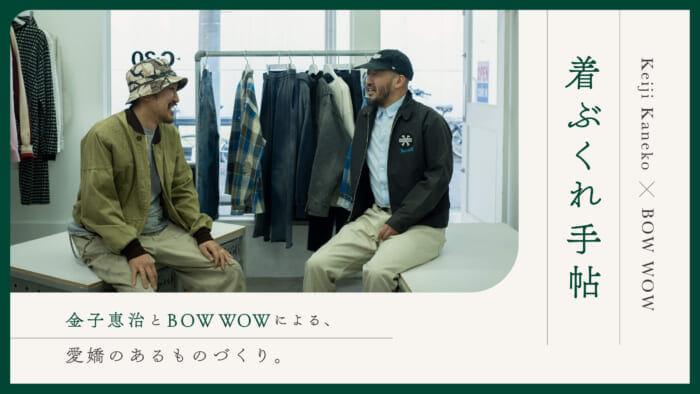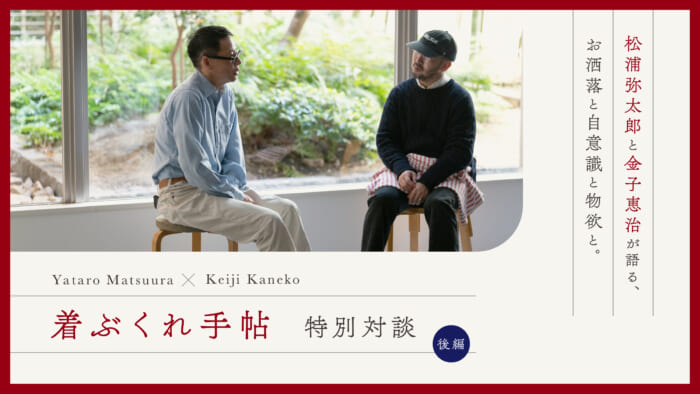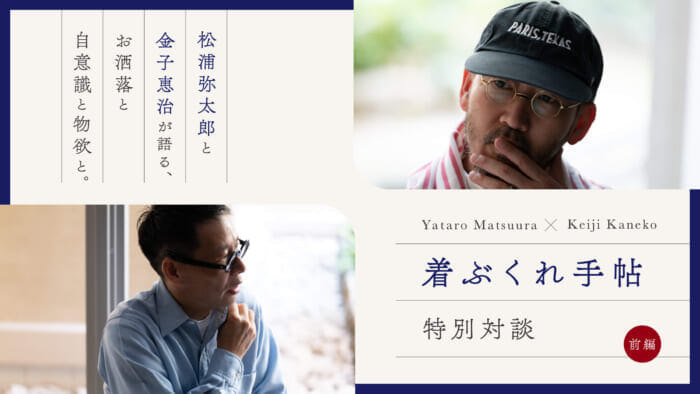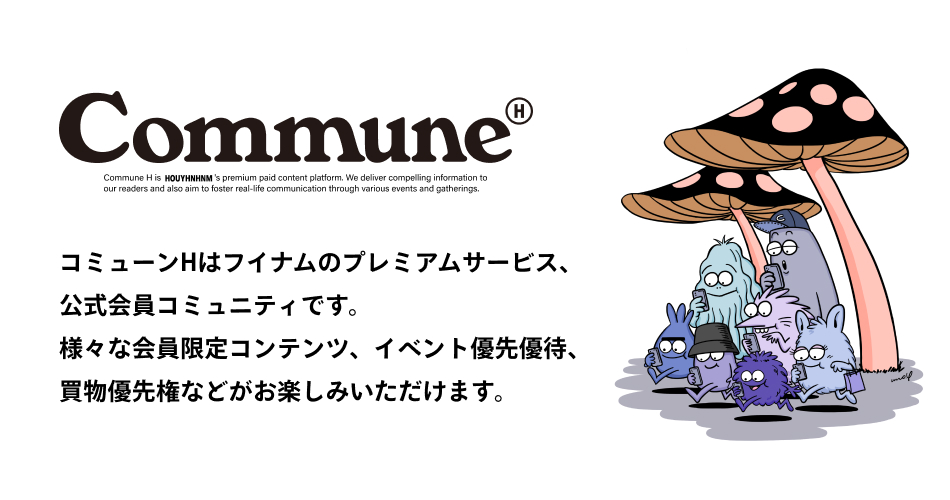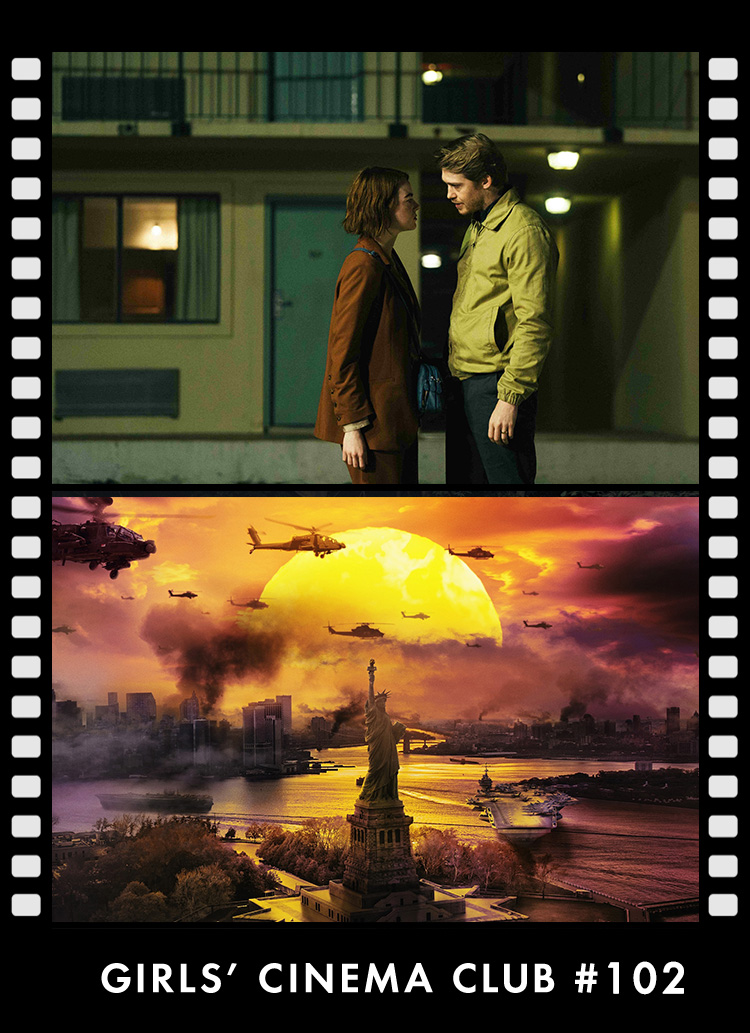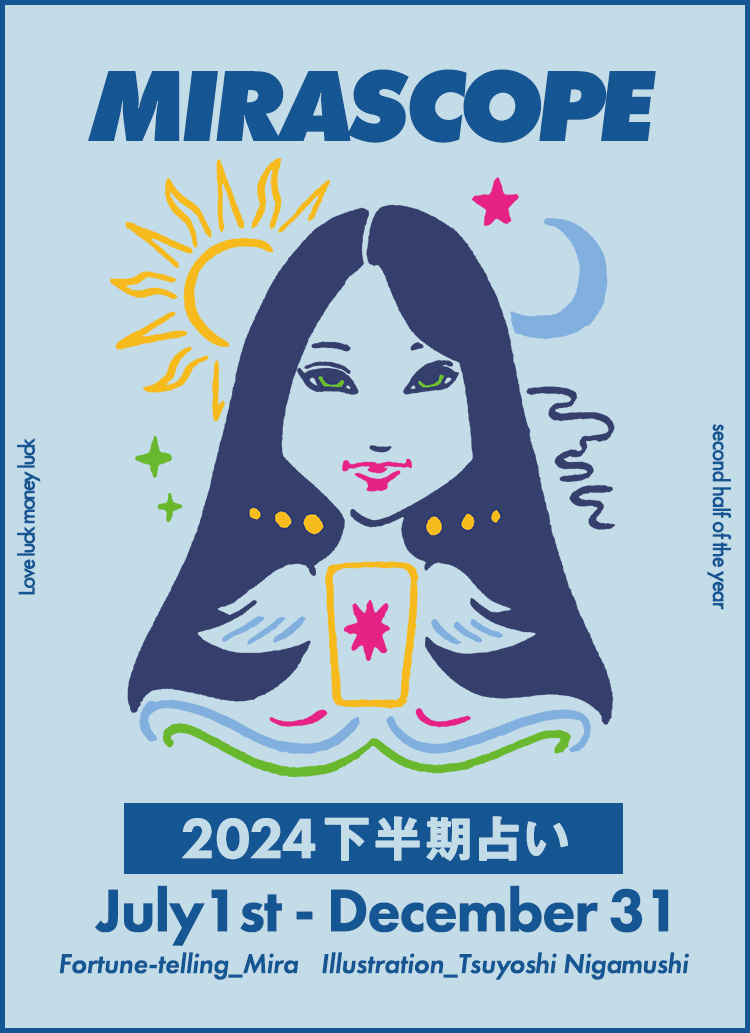PROFILE
Fashion buyer. After working as a buyer at the select store "Edifice", he became independent. After working on his own, he launched "Reshop" in 2015. Currently, he is the conceptor of the store and also supervises various brands and labels.
PROFILE
Born in Ibaraki Prefecture in 1983, he established the eyewear brand "Ayame" in 2010. In addition to this brand, he also designs and directs other eyewear brands. His hobby is surfing.
The atmosphere of celluloid as an object is definitely better.

This time, the two of you made sunglasses by sampling a certain sports brand's famous eyewear.
Kaneko: That's right. I was convinced that this model was a classic and would look good on anyone.
Imaizumi: I understand that feeling so much.

Kaneko: It is a sports brand item, and since I ride a bicycle, many people around me wear them. They are not in the fashion business, but they all look good on me. However, since they are made for sports, they have brand logos on the temples and are made of suitable materials. Our concept this time was to make them more fashionable and wearable in everyday life.
So you are taking quality made for sports and converting it to fashion.
Kaneko: You are right. The original model was a Japanese item made in the 80's, but it was made a little differently from the same model currently in circulation. Generally, the temples of those models can be easily detached, but the ones I had were hinged and made like regular eyewear.
Imaizumi: For those who know the "example model," it was very unusual.
Kaneko: That was the inspiration for this project. I thought it would be possible to create eyewear with solid specifications, not just eliminate the logo on the temples.
So that's why you were chosen.
Kaneko: He surfs, so I thought he was well versed in the appeal of the original model, and although he looks mischievous at first glance, he makes glasses for adults. I thought that Mr. Imaizumi was the only person who could realize my idea (laugh).
Imaizumi: I see, so that's how it happened (laughs).
Kaneko: Did you have the "model" as well?

Imaizumi: I have them. They are typical sports sunglasses. But to be honest, I don't take them that seriously. I like the relaxed nature of it. They are the kind of item that I take with me when I go to the beach, but for some reason, I have an attachment to them that I can't let go of.
What did you feel when you received the offer?
Imaizumi: As Mr. Kaneko mentioned earlier, the eyewear you brought to us was made a little differently from the "example model" that is generally distributed. It was the first time for me to see hinges on the eyewear. I also noticed that there is no core.
What do you mean by that?
Imaizumi: Basically, eyewear has a core in the temples. This is to enhance durability, but "the model in question" does not have a core.
Kaneko: Does that change the material?
Imaizumi: It changes. In general, eyewear nowadays is usually made of acetate. However, the "example model" is made using an "injection" method, in which resin is poured into a mold.
So, do you mean that the items for "Ayame" this time were also made by the injection method?

Imaizumi: No, it is not practical to use injection molds now because the cost of molds is so high. Therefore, celluloid is used this time. It requires an old-fashioned technique, and only about 0.11 TP10T is produced in the domestic market nowadays. There is a craftsman in Sabae who has such a technique.
Kaneko: Why are there so few produced?
Imaizumi: Celluloid is a difficult material to handle, and the number of craftsmen who can handle it is decreasing. It is a highly flammable material, so there is a risk of catching fire due to friction while grinding or polishing. Basically, it is treated as a hazardous material, so it cannot be transported by air.
Is it hardly used in other countries?
Imaizumi: It's almost never there. You can't take it with you, and you probably don't even produce it. I think most of them are only distributed in Asia now.
Why celluloid in this case?
Imaizumi: As we talked about earlier, finishing temples without using a core requires strength. In the case of acetate, that is insufficient, but celluloid has viscosity, so it is hard to break. In addition, celluloid is a material with a certain flavor. In particular, the coloring is unique to celluloid. Compared to acetate, it is a bit muddy, and the color is called "smoke" instead of gray or "beer" instead of brown.

Kaneko: Indeed, the one we made this time looks like a beer bottle, doesn't it?
Imaizumi: Since this material was used before acetate, I also recognize it as the original color of eyeglasses.
Kaneko: There is a certain quality to the material, isn't there? Celluloid is definitely better as a material.

Imaizumi: Also, the gloss is different. If it is made by injection, it is only finished by varnishing, so it is impossible to get that effect. With celluloid, however, the final step is polishing, and the craftsmanship of Japanese craftsmen is truly amazing. Compared to products made overseas, there is an overwhelming difference, and they are simply beautiful. I really think that eyewear is a product suited to the fine work that Japanese people are good at.
Kaneko: Even if they are hurt, I think it will turn out to be an attraction.
Imaizumi: Celluloid becomes shiny when it dries out, but it can be polished again to restore its luster. The same is true for acetate, but frames of eyeglasses can last a long time if they are properly washed.
Kaneko: In that sense, they may resemble leather shoes.
Imaizumi: It is interesting that the original item was so casual, but it was made to look so luxurious.
Kaneko: That was my goal. That's what I was aiming for.



